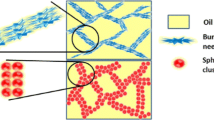Abstract
The objective of this work was to evaluate the effect of high intensity ultrasound (HIU) on the physical properties of a commercial shortening crystallized at a constant temperature and during temperature cycling at two different cooling rates (0.5 and 1 °C/min). Different ultrasound power levels and different durations were evaluated during crystallization at a constant temperature and the best conditions were used to evaluate the effect of HIU during temperature cycling. The physical properties tested were crystal microstructure, viscoelasticity, and melting profile. Results show that HIU is more efficient at changing crystal microstructure when used at 20 °C using a 1/2″ tip. No difference was found on the microstructure of the crystals formed when different durations of ultrasound exposure were tested. A significant increase (p < 0.05) was observed in the storage modulus (G′) of the lipid exposed to temperature fluctuations with the use of HIU. The G′ values increased from 662.6 ± 176.8 Pa (no HIU applied) to 3,365.5 ± 426.4 Pa (with HIU applied, 0.5 °C/min) and from 354.4 ± 49.7 Pa (no HIU applied) to 1,249.0 ± 19.8 Pa (with HIU applied, 1 °C/min).








Similar content being viewed by others
References
Goff HD (1997) Instability and partial coalescence in whippable dairy emulsions. J Dairy Sci 80(10):2620–2630
Wright AJ, Scanlon MG, Hartel RW, Marangoni AG (2001) Rheological properties of milkfat and butter. J Food Sci 66(8):1056–1071
Foubert I, Dewettinck K, Vanrolleghem PA (2003) Modelling of the crystallization kinetics of fats. Trends Food Sci Technol 14(3):79–92
McCausland LJ, Cains PW, Martin PD (2001) Use the power of sonocrystallization for improved properties. Chem Eng Prog 97(7):56–61
Patrick M, Blindt R, Janssen J (2004) The effect of ultrasonic intensity on the crystal structure of palm oil. Ultrason Sonochem 11(3–4):251–255
Kordylla A, Krawczyk T, Tumakaka F, Schembecker G (2009) Modeling ultrasound-induced nucleation during cooling crystallization. Chem Eng Sci 64(8):1635–1642
Beckmann W, Nickisch K, Budde U (1998) Development of a seeding technique for the crystallization of the metastable A modification of Abecarnil. Org Process Res Dev 2(5):298–304
Beckmann W (2000) Seeding the desired polymorph: background, possibilities, limitations, and case studies. Org Process Res Dev 4(5):372–383
Cerdeira M, Martini S, Candal RJ, Herrera ML (2006) Polymorphism and growth behavior of low-trans fat blends formulated with and without emulsifiers. J Am Oil Chem Soc 83(6):489–496
Martini S, Herrera ML (2008) Physical properties of shortenings with low-trans fatty acids as affected by emulsifiers and storage conditions. Eur J Lipid Sci Technol 110(2):172–182
Martini S, Herrera ML, Hartel RW (2001) Effect of cooling rate on nucleation behavior of milk fat-sunflower oil blends. J Agric Food Chem 49(7):3223–3229
Narducci O, Jones AG, Kougoulos E (2011) Continuous crystallization of adipic acid with ultrasound. Chem Eng Sci 66(6):1069–1076
Narducci O, Jones AG (2012) Seeding in situ the cooling crystallization of adipic acid using ultrasound. Cryst Growth Des 12(4):1727–1735
Chow R, Blindt R, Chivers R, Povey M (2005) A study on the primary and secondary nucleation of ice by power ultrasound. Ultrasonics 43(4):227–230
Patel SR, Murthy ZVP (2009) Ultrasound assisted crystallization for the recovery of lactose in an anti-solvent acetone. Cryst Res Technol 44(8):889–896
Bund RK, Pandit AB (2007) Sonocrystallization: effect on lactose recovery and crystal habit. Ultrason Sonochem 14(2):143–152
Martini S, Suzuki AH, Hartel RW (2008) Effect of high intensity ultrasound on crystallization behavior of anhydrous milk fat. J Am Oil Chem Soc 85(7):621–628
Ye Y, Wagh A, Martini S (2011) Using high intensity ultrasound as a tool to change the functional properties of interesterified soybean oil. J Agric Food Chem 59(19):10712–10722
Suzuki AH, Lee J, Padilla SG, Martini S (2010) Altering functional properties of fats using power ultrasound. J Food Sci 75(4):E208–E214
Higaki K, Ueno S, Koyano T, Sato K (2001) Effects of ultrasonic irradiation on crystallization behavior of tripalmitoylglycerol and cocoa butter. J Am Oil Chem Soc 78(5):513–518
Patrick M, Blindt R, Janssen J (2004) The effect of ultrasonic intensity on the crystal structure of palm oil. Ultrason Sonochem 11:251–255
Chen F, Zhang H, Sun X, Wang X, Xu X (2013) Effects of ultrasonic parameters on the crystallization behavior of palm oil. J Am Oil Chem Soc 90:941–949
Martini S, Tejeda-Pichardo R, Ye Y, Padilla SG, Shen FK, Doyle T (2012) Bubble and crystal formation in lipid systems during high-intensity insonation. J Am Oil Chem Soc 89:1921–1928
Martini S, Potter R, Walsh MK (2010) Optimizing the use of high intensity ultrasound to decrease turbidity in whey protein suspensions. Food Res Int 43:2444–2451
AOCS Cd 16b-93 (2009) Solid fat content (SFC) by low resolution nuclear magnetic resonance—the direct method. AOCS Press, Urbana
Virone C, Kramer HJM, van Rosmalen GM, Stoop AH, Bakker TW (2006) Primary nucleation induced by ultrasonic cavitation. J Cryst Growth 294(1):9–15
Suslick KS (1988) Ultrasound: its chemical, physical, and biological effects. VCH, New York
Guo Z, Jones AG, Li N (2006) The effect of ultrasound on the homogeneous nucleation of BaSO4 during reactive crystallization. Chem Eng Sci 61(5):1617–1626
Kim SJ, Wei CK, Kiang S (2003) Crystallization process development of an active pharmaceutical ingredient and particle engineering via the use of ultrasonics and temperature cycling. Org Process Res Dev 7(6):997–1001
Herrera ML, Hartel RW (2000) Effect of processing conditions on physical properties of a milk fat model system: rheology. J Am Oil Chem Soc 77(11):1189–1195
Acknowledgments
This work was supported by Mondelēz International and Utah State University. The authors would like to thanks Mondelēz International for providing the shortening. This research was approved by the Utah Agricultural Experiment Station as paper number 8475.
Author information
Authors and Affiliations
Corresponding author
About this article
Cite this article
Ye, Y., Tan, C.Y., Kim, D.A. et al. Application of High Intensity Ultrasound to a Zero-trans Shortening During Temperature Cycling at Different Cooling Rates. J Am Oil Chem Soc 91, 1155–1169 (2014). https://doi.org/10.1007/s11746-014-2458-6
Received:
Revised:
Accepted:
Published:
Issue Date:
DOI: https://doi.org/10.1007/s11746-014-2458-6




